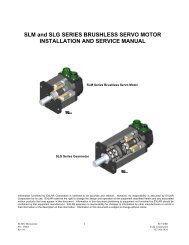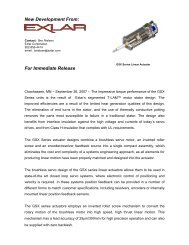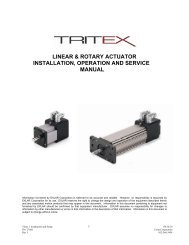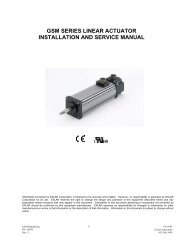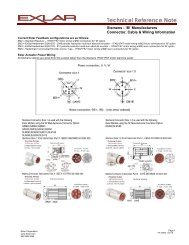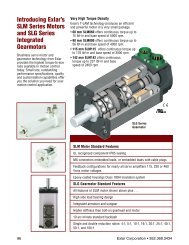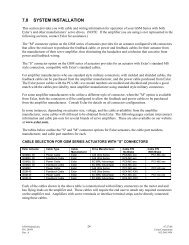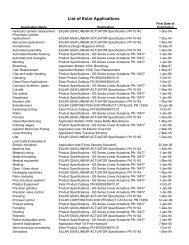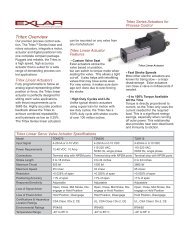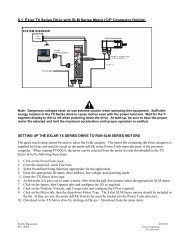You also want an ePaper? Increase the reach of your titles
YUMPU automatically turns print PDFs into web optimized ePapers that Google loves.
Sizing and Selection of <strong>Exlar</strong> Linear Actuators<br />
Terms and (units)<br />
THRUST = Total linear force-lbf (N)<br />
Ø = Angle of inclination (deg)<br />
Ffriction = Force from friction-lbf (N)<br />
tacc = Acceleration time (sec)<br />
Facc = Acceleration force-lbf (N)<br />
v = Change in velocity-in/sec (m/s)<br />
Fgravity = Force due to gravity-lbf (N)<br />
µ = Coefficient of sliding friction<br />
Fapplied = Applied forces-lbf (N)<br />
(refer to table on page 136 for different materials)<br />
WL = Weight of Load-lbm (kg)<br />
g = 386.4: Acceleration of gravity - in/sec 2 (9..8 m/sec 2 )<br />
Thrust Calculations<br />
Definition of thrust:<br />
The thrust necessary to perform a<br />
specific move profile is equal to the sum<br />
of four components of force. These are<br />
the force due to acceleration of the<br />
mass, gravity, friction and applied forces<br />
such as cutting and pressing forces and<br />
overcoming spring forces.<br />
WLOAD<br />
F app.<br />
Thrust Calculation Equations<br />
THRUST = Ffriction + [Facceleration] + Fgravity + Fapplied<br />
THRUST = WLµcosø + [(WL /386.4) (v/tacc)] + WLsinø + Fapplied<br />
θ<br />
Angle of Inclination<br />
Sample Calculations: Calculate the thrust required to accelerate a<br />
200 pound mass to 8 inches per second in an acceleration time of 0.2<br />
seconds. Calculate this thrust at inclination angles(q) of 0˚, 9.0˚ and<br />
30˚. Assume that there is a 25 pound spring force that is applied<br />
against the acceleration.<br />
90˚<br />
-90˚<br />
0˚<br />
Note: at ø = 0˚<br />
cosø = 1; sinø = 0<br />
at ø = 9.0˚<br />
cosø = 0; sinø = 1<br />
WL = 200 lbm, v = 8.0 in/sec., ta = 0.2 sec., Fapp. = 25 lbf, µ = 0.15<br />
ø = 0˚<br />
THRUST = WLµcosq + [(WL /386.4) (v/tacc)] + WLsinø + Fapplied<br />
= (200)(0.15)(1) + [(200/386.4)(8.0/0.2)] + (200)(0) + 25<br />
= 30 lbs + 20.73 lbs + 0 lbs + 25 lbs = 75.73 lbs force<br />
ø = 9.0˚<br />
THRUST = WLµcosq + [(WL /386.4) (v/tacc)] + WLsinq + Fapplied<br />
= (200)(0.15)(0) + [(200/386.4)(8.0/0.2)] + (200)(1) + 25<br />
It is necessary to calculate the required<br />
thrust for an application during each<br />
portion of the move profile, and<br />
determine the worst case criteria. The<br />
linear actuator should then be selected<br />
based on those values. The calculations<br />
at the right show calculations during<br />
acceleration which is often the most<br />
demanding segment of a profile.<br />
= 0 lbs + 20.73 lbs + 200 lbs + 25 lbs = 245.73 lbs force<br />
ø = 30˚<br />
THRUST = WLµcosq + [(WL /386.4) (v/tacc)] + WLsinq + Fapplied<br />
= (200)(0.15)(0.866) + [(200/386.4)(8.0/0.2)] + (200)(0.5) + 25<br />
= 26 lbs + 20.73 lbs + 100 + 25 = 171.73 lbs force<br />
9.52.500.6200 | www.exlar.com 147



